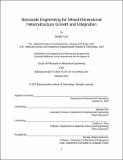Nanoscale Engineering for Mixed-Dimensional Heterostructure Growth and Integration
Author(s)
Lee, Sangho
DownloadThesis PDF (4.358Mb)
Advisor
Kim, Jeehwan
Ross, Caroline A.
Terms of use
Metadata
Show full item recordAbstract
Recent attempts to create van der Waals (vdW)-bonded heterostructures of distinct twodimensional (2D) crystals has opened new avenues for research, from the fundamental studies of emergent phenomena to the development of practical applications with unique functionalities, which are attributed to a wide variety of configurations attainable with no lattice and processing limitations. Despite compelling opportunities in the field of vdW heterostructures, it still faces a couple of fundamental limitations in scalability, tunability, and degree of physical coupling of electronic properties. On the other hand, remote epitaxy – an emerging growth method of singlecrystalline membranes copied from the underlying substrates through the atomically thin graphene interlayer – has been alternatively suggested to solve major challenges in all-2D vdW heterointegration as well as in conventional heteroepitaxy, resulting in high-quality threedimensional (3D) thin films that can be released from weak vdW interface and transferred/stacked onto arbitrary substrate/layer of interest. Therefore, graphene-based layer transfer technique offers an efficient route to produce all-3D artificial heterostructures analogous to all-2D vdW heterostructures, but 3D components here are expected to show more enhanced physical coupling at their interfaces and a wider range of materials including III-Vs, III-Ns, and complex-oxides, which in general outperforms 2D counterparts in material properties, can be considered as a building block to form heterogeneous stacks. However, remote epitaxy is still in infancy to work universally for all material systems and all epitaxy techniques.
In this thesis, nanoscale engineering is introduced to tackle major challenges in current technologies, especially in remote epitaxy, and to propose new strategies to assemble or integrate a broad range of mixed-dimensional heterostructures that are distinct from the vdW heterostructure counterparts. Three case studies are presented to exemplify how material design and engineering at nanoscale are leveraged to solve long-standing problems that are not readily overcome through the conventional techniques and methodologies: 1) nanopatterned graphene-based universal epitaxy for single-crystalline membrane transfer; 2) freestanding complex-oxide membrane growth and transfer via sacrificial interlayer for emergent multiferroics; and 3) self-assembled block copolymer thin films templating hybrid nanostructures.
Date issued
2022-02Department
Massachusetts Institute of Technology. Department of Mechanical EngineeringPublisher
Massachusetts Institute of Technology